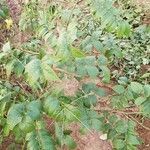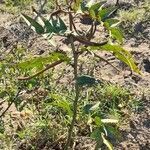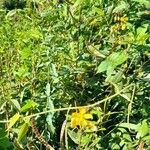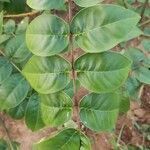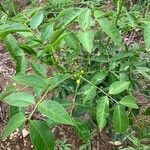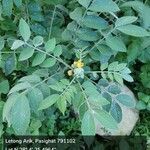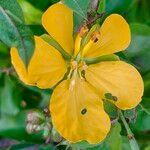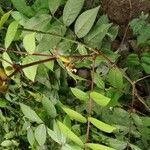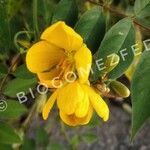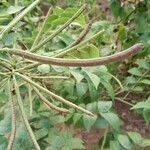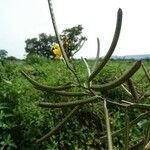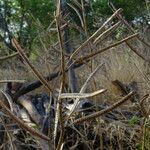Erect, subglabrous, foetid herb or undershrub 1.5-2 m tall, usually annual (in any case in seasonal climates). Stipules triangular to linear-acute, more or less falcate, 1-2 cm long. Leaves with 3-5(-6) pairs of leaflets; petiole 3-4 cm long with a relatively large, ovoid gland just above the petiole joint; rachis 8-12 cm. Leaflets membranous, ovate-oblong, more or less unequal-sided, 4-10 by 2-3 cm, apex acuminate, base rounded; upper surface glabrous, lower glabrous or more or less pruinose to finely puberulous; petiolule c. 2 mm. Racemes short peduncled (2-4 mm), 2-4-flowered, mainly terminal; bracts linear-acute, caducous; pedicels 5-10 mm. Sepals unequal, outer ones orbicular, c. 6 mm diam., inner ones ovate, larger. Petals yellow with violet veins, 2 outer slightly larger, 1-2 by 1.5 cm, short-clawed. Stamens: 2 long with filaments 5-6 mm long, anthers 5-7 mm long, opening by apical pores; 4 with filaments 2-3 mm and anthers 5-6 mm opening the same way; reduced stamens with 3-4 mm long filaments and tiny anthers. Ovary tomentose; style glabrous; stigma lateral, small. Pods linear, flattened, glabrous or nearly so, brown with pale margins, 10-12 by 1 cm. Seeds 30-40, flat, orbicular, 3-4 mm diam.
An erect herb, sometimes woody at the base, 0.5-1(2) m high. Stems ridged, subglabrous. Leaves paripinnate; petiole 2.8-6 cm long, with a single large dome-or cone-shaped gland close to the base; rachis 5-12.6 cm long, eglandular; leaflets in 4-5 pairs, 2.9-12 x 1.2-4.2 cm, the distal pair largest, ovate to ovate-elliptic, acute to acuminate, base asymmetric, upper side cuneate, lower side rounded, glabrous except for a few hairs and scattered small glands on the petiolules and margins. Inflorescences axillary racemes, very short, almost umbellate; peduncles mostly 3-5 mm long. Sepals 5, c. 7 x 3-5 mm, obovate, glabrous. Petals yellow, dark veined when dry, c. 8 mm in diameter with a claw 1-2 ram long, obovate to subcircular. Stamens 10; five probably fertile of which two with anthers 5-6 mm long and three with anthers c. 4 mm long, live apparently sterile with reduced flattened anthers. Ovary 8-9 mm long, appressed-pubescent; style 3-4 mm long, glabrous except for a few hairs near the tip. Pod 8-12 x 0.8-1 cm, straight or slightly curved, tardily dehiscent or indehiscent, many-seeded. Seeds buff, c. 4.5 mm in diameter, suborbicular, verruculose, with an elliptic areole on each face.
Subshrubs or shrubs, erect, 0.8-1.5 m tall, glabrous, few branched. Branches herbaceous, ribbed; roots blackish. Leaves ca. 20 cm; stipules caducous, triangular to lanceolate, 1-2 cm, membranous; petiole 3-4 cm, with a large, brown, ovoid gland near base; petiolule 1-2 mm, with a rotten smell when kneaded; leaflets 3-5(or 6) pairs, ovate to ovate-oblong, 4-10 × 2-3.5 cm, membranous, base rounded, apex acuminate. Corymbose racemes few flowered, axillary or terminal, ca. 5 cm; bracts caducous, linear-lanceolate. Flowers ca. 2 cm. Sepals unequal, outer ones suborbicular, ca. 6 mm in diam., inner ones ovate, 8-9 mm. Petals yellow, purplish veined, 2 outer slightly larger, shortly clawed. Fertile stamens 7, anthers opening by apical pores, reduced stamens 3, without anthers or with tiny anthers. Ovary tomentose; style glabrous. Legume brown, with pale thick margins, strap-shaped, falcate, flattened, 10-13 × ca. 1 cm, with septa between seeds. Seeds 30-40, flat, orbicular, 3-4 mm in diam. 2n = 24, 26*, 28*, 56*.
An annual herb or small shrub. It can continue growing for a few years. It grows 1-2.5 m high. The stems have few hairs. The leaf stalk has a gland at the base but there is no gland along the leaf axis. The leaves are compound. There are 4-6 pairs of leaflets. The leaf stalk is 2-3 cm long. The leaflets are oval and 4-12 cm long by 1.5-4 cm wide. They taper to the top and are rounded at the base. The flower stalks are very short. The flower cluster is in the axils of leaves. The petals are yellow and 0.9-1.5 cm long. The fruit is a narrow, slightly curved pod. It is 5-10 cm long by 0.5-1 cm wide. It has pale edges. They are flattened. They usually dry with a brown area along the pod. The seeds are compressed. There are 28-32 seeds inside. They are green or brown. They are 5 mm long. There are small pits on each side.
Shrub, erect, to 2 m high, pubescent on vegetative parts, inflorescence, sepals and ovary, soon glabrescent. Leaves 15–17 cm long including a ribbed petiole 20–40 mm long; stipules acicular, caducous; leaflets in 3–7 pairs spaced 15–30 mm apart, broadly elliptic to ovate, 50–70 mm long, 30–40 mm wide, increasing distally, acute and acuminate; gland 1, very near petiole base, sessile, broader than tall. Inflorescences of 2–4 flowers, terminal and in upper axils, paniculate; peduncle 2–5 mm long; pedicels 10–15 mm long; bracts caducous. Petals to 10 mm long. Fertile stamens 6, with 3 adaxial and 1 abaxial staminodes; fertile filaments distinctly unequal, 2–8 mm long; fertile anthers distinctly unequal, 4–6 mm long, with short beaks. Pod cylindric, 12–18 cm long, c. 3 mm diam., slightly curved, entire. Seeds dull.
Annual or short-lived perennial up to 2 m high; stems ridged, glabrous with age. Leaves 120-200 mm long. Leaflets 4 to 5 pairs, increasing in size distally on rachis, ovate-elliptic, base rounded to asymmetric, apex acute to acuminate, surfaces densely glandular when young. Stipules asymmetric, ovate to lanceolate, acute, caducous. Inflorescences in axils of upper leaves, subumbellate racemes. Flowers 2-4-flowered, pale yellow. Flowering time Feb., Mar., or all year. Pod ascending, flattened, linear-oblong, 80-120 x 5-10 mm. Valves dark brown, edges light brown, glabrate, coriaceous, corrugated over seeds, internally septate with papery walls between seeds. Seeds single row, ovate, laterally compressed, olivaceous, bearing oblong areole on each face.
Annual (in our range), 3–10 dm, malodorous, bearing in each upper axil a single fl or 2–3 fls in a raceme with a very short common axis; gland depressed or dome-shaped, near the base of the petiole; lfls 3–6 pairs, ovate to elliptic or lance-ovate, 3–8 cm, acuminate; buds nodding; sep unequal; pet 10–15 mm, slightly dissimilar; pods straight or slightly curved, flattened, 7–14 cm × 6–9 mm, tardily dehiscent, glabrous or sparsely hairy, weakly segmented; seeds 4–5 mm, flattened-obovoid with depressed center; 2n=28. Native of the Old World tropics, widely naturalized in the warmer parts of the New World, extending n. to N.C. and Ark., and rarely in our range as an adventive. Late summer. (Cassia o.; Ditremexa o.)
Annual or short-lived perennial herb or shrub, up to 2 m high. Young stem apices ridged. Leaflets ovate, 20-40 mm wide. Peduncles at flowering 3-5 mm long. Bracts acuminate to narrowly acute. Pods linear, 80-130 x 5-8 mm. Flowers pale yellow with brown venation.
